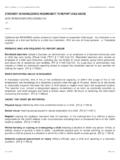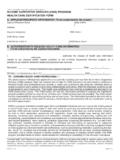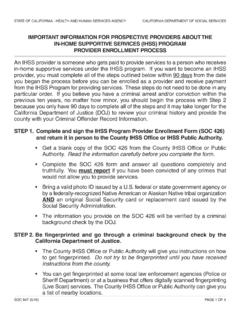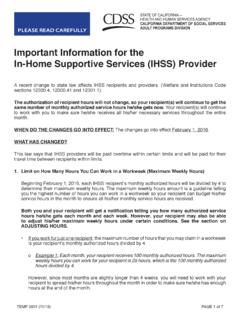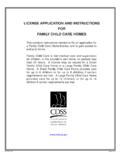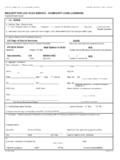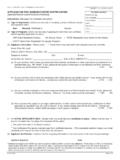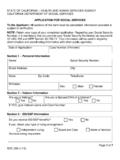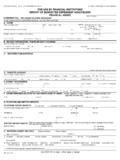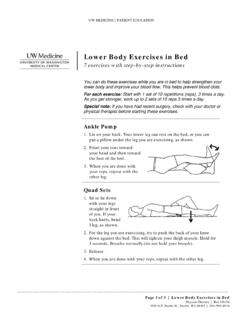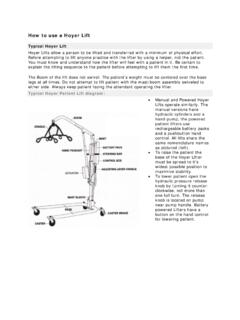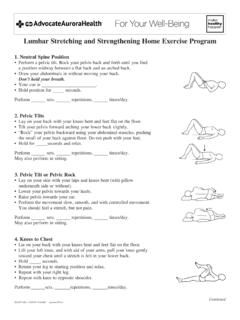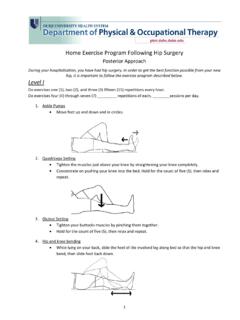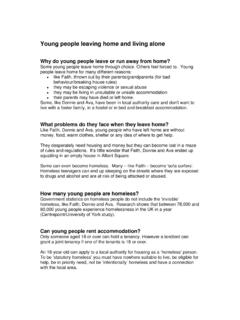Transcription of How to Use a Hoyer Lift - California Department of Social ...
1 1 How to Use a Hoyer Lift Typical Hoyer Lift Hoyer Lifts allow a person to be lifted and transferred with a minimum of physical effort. Before attempting to lift anyone practice with the lifter by using a helper, not the consumer. You must know and understand how the lifter will feel with a consumer in it. Be certain to explain the lifting sequence to the consumer before attempting to lift them the first time. The Boom of the lift does not swivel. The consumer's weight must be centered over the base legs at all times. Do not attempt to lift consumer with the mast/boom assembly swiveled to either side. Always keep the consumer facing the attendant operating the lifter.
2 Typical Hoyer Consumer Lift diagram: Manual and Powered Hoyer Lifts operate similarly. The manual versions have hydraulic cylinders and a hand-pump, the powered consumer lifters use rechargeable battery packs and a pushbutton hand control. All lifts share the same nomenclature names as pictured (left). To raise the consumer the base of the Hoyer Lifter must be spread to its widest possible position to maximize stability. To lower consumer open the hydraulic pressure release knob by turning it counter-clockwise, not more than one full turn. The release knob is located on pump near pump handle. Battery powered Lifters have a button on the hand control for lowering consumer.
3 2 Transfer from Bed If consumer needs support and is in a hospital bed, raise side rails and have consumer hold onto rails. Raise the level of the bed to the highest position before moving the consumer onto the sling. This will reduce strain on the caregiver's back. Also, when the consumer is ready to be lifted, lower the side rail and the level of the bed, decreasing the distance the consumer has to be elevated. Positioning the lift for use: 1. With the legs of the base open and locked, use the steering handle to push the consumer lift into position. 2. Lower the consumer lift for easy attachment of the sling. When the consumer is clear of the bed surface, swing their feet off the bed.
4 Using the steering handle, move the lift away from the bed. When moving the consumer lift away from the bed, turn the consumer so that he/she faces assistant operating the consumer lift. Press the DOWN button (electric) or open the control valve (manual/hydraulic) lowering consumer so that his feet rest on the base of the lift, straddling the mast. Close the control valve. 3 The Sling The U-Sling is the most commonly used sling for transferring consumer from bed. Consult the sling manual on how to fold the sling before placing under consumer. Folding the sling makes for less work. These U-Sling wraps around the thigh and cross between the legs.
5 This gives the consumer a secure feel and prevents consumer sliding out of the sling. Below is a diagram of a typical "Internet image" (see diagram 1) of a typical padded U-Sling. The image is meaningless if you do not have a visual of what this looks like when in actual use. See diagram 2 showing the consumer in a comfortable seated position facing the attendant. Feet should rest on the base of the lift. Typical U-Sling diagram 1 Typical U-Sling diagram (Internet image) diagram 2 Visual of sling being used by consumer 4 Applying the sling: Roll consumer so they are resting on their side. Put the folded sling behind consumer's back and roll consumer onto their back.
6 Pull the leg loops forward and under the thigh. Cross the loops Roll the base as far under the bed as possible locating the cradle over the consumer. Be careful not to lower the frame onto the consumer. The parking brakes (caster locks) should not be on when lifting the consumer, let the lift move a little with the weight adjustment. When both sides of the sling are attached to their respective sides of the cradle, raise the consumer slowly. If consumer is in a hospital bed it will help to raise the head section slightly. Raise the consumer until buttocks are just above the mattress. The self-leveling cradle will bring consumer into a sitting position.
7 Grasp consumer's legs and turn consumer so their legs dangle off side off the bed. Do not push or pull consumer off of bed. Lower the bed if you need more clearance. Grasp steering handles and move lifter away from the bed. Move consumer into position over the seat of wheelchair. Make sure wheelchair brakes are on. Lower consumer into wheelchair or other transport device. How to fit sling from lying position: Draw sheet roll the consumer onto the sling, ensuring that the top of the commode aperture is at the base of the spine. Bring the leg support straps up and between the client's legs and proceed as from the seated position, attaching to the shortest possible loops.
8 If you are going to place the consumer on a high bed it may be necessary to lower the consumer onto an intermediate surface and adjust the strap length. 5 Detailed Directions for Using Common Hoyer Slings and Consumer Lift Slings 1. Arrange all items for a smooth transfer - lifter, sling, and wheelchair. 2. Consumer should be in center of twin size bed or to one side of double size bed. 3. Roll consumer on side away from attendant. (Raise side rail, if equipped, on side opposite attendant). 4. For full hammock style slings place sling folded half-way under consumer so cut-out is just below tail-bone. 5. Place wider piece (seat) under consumer's thighs so lower edge of seat is up to knees.
9 Place narrower piece (back) just above small of back. If consumer is in a hospital bed, position seat sling, then elevate head of bed to facilitate placing back piece. 6. Place sling folded half-way under consumer so lower edge of seat is slightly below the knees. 7. Roll consumer towards attendant. Pull sling through (like positioning draw sheet). 8. If consumer is in chair, you may place sling under consumer without lifting consumer by following these few simple steps: a. Have leg flaps open. b. Have consumer lean forward slightly and slide open portion of sling down to seat and lay leg flaps alongside consumer's legs. c. Grasp leg flap on one side of consumer and, while holding against knee, pull leg flap forward; repeat with other side until sling is in correct position.
10 D. Bring flap under one thigh and insert ring (A) into snap (A). Repeat for other leg, inserting ring (B) into snap (B), thus enclosing a thigh in each leg flap. e. If you wish to use the sling without containing the thighs, follow instructions above but bring ring (A) to snap (B) and ring (B) to snap (A), crisscrossing flaps under the leg. 9. It will help to raise the head of bed after sling is positioned if consumer is in a hospital bed. For slings/lifts with chains: 1. Attach the S-hooks of the chain to the loops of the seat hangers. Hooks should be inserted AWAY from the consumer to the outside of the sling. 2. Attach the ends of the chains to the swivel bar hooks.
